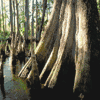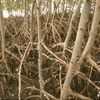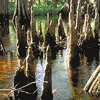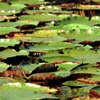
All About Wetlands >> Vegetation
Wetland Vegetation
Not all plants can survive in wetland ecosystems. Wetland habitats, with their high water levels and increased salt concentrations, are too harsh for many plants. Most organisms that thrive in these environments only do so with the help of special physiological and morphological adaptations.
Common characteristics of wetland plants
 buttressed
tree trunk -- these tree trunks swell out at the base for additional
support in the water. (examples: bald cypress, water tupelo, swamp
blackgum)
buttressed
tree trunk -- these tree trunks swell out at the base for additional
support in the water. (examples: bald cypress, water tupelo, swamp
blackgum)
 adventitious roots and shallow root systems-- roots grow near the
surface where they can obtain oxygen (examples: mangroves)
adventitious roots and shallow root systems-- roots grow near the
surface where they can obtain oxygen (examples: mangroves)
 pneumatophores
-- modified root systems, sometimes above ground, to increase respiration.
pneumatophores
-- modified root systems, sometimes above ground, to increase respiration.
 floating
leaves -- leaves with a thick cuticle (skin) to prevent water penetration
(examples: lily pads)
floating
leaves -- leaves with a thick cuticle (skin) to prevent water penetration
(examples: lily pads)
floating stems -- stems with large internal air spaces that allow plants to root in shallow water and float
inflated leaves, stems, roots -- spongy tissues in leaves, stems and roots provide buoyancy and an oxygen reservoir (examples: herbaceous plants, including cattails, bulrush)
hypertrophied venticals -- large pores on plant stems make oxygen exchange easier
prolonged seed viability -- seeds will learn for 20 years so they can postpone germination until a wet area dries and then they are exposed to air
seed germination under low oxygen conditions -- seeds germinate when submerged and don't have to wait for air exposure
physiological adaptations --
- ability to grow in low oxygen conditions
- ability to transfer oxygen from roots into surrounding soil (prevents root deterioration and assists in water and nutrient absorption)
- special cells in roots that prohibit salt uptake
- have excretory cells to eliminate salt (example: coastal marsh grass leaves excrete salt crystals).
Plants based on wetland type
Invasion of Non-native Species
Non-native wetland plants are beginning to rule the landscape in many wetlands. This causes a huge diversity problem because the native vegetation is not naturally able to compete with these invaders.
Learn more about invasive exotic vegetation.